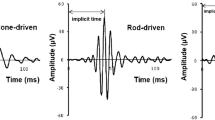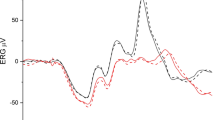Abstract
The purpose of this study was to examine the origin of the oscillatory potentials (OPs) recorded at the onset of dark-adaptation. Our results show that following pre-exposure of the retina to progressively brighter photopic backgrounds there is a complete abolition of OP4 and approximately 50% of OP3, while OP2 is not affected in responses evoked to dim flashes of white light and recorded at the onset of dark-adaptation. These results bring further support to the claim that the short latency OP2 is cone-mediated while the OP3 and OP4 would have a significant rod contribution. However, a more complex picture of OP genesis arises when flicker and response to brighter white light flashes, also obtained within the first minute of dark-adaptation are considered. The latter would suggest that our understanding of the origin of the OPs cannot be exclusively based on which of the two class of photoreceptors is preferentially stimulated at the time the response is recorded.
Similar content being viewed by others
References
Lachapelle P, Rousseau S, McKerral M, Benoit J, Polomeno RC, Koenekoop RK, Little JM. Evidence supportive of a functional discrimination between photopic oscillatory potentials as revealed with cone and rod mediated retinopathies. Doc Ophthalmol 1998; 95: 35–54.
King-Smith PE, Loffing DH, Jones R. Rod and cone ERGs and their oscillatory potentials. Invest Ophthalmol Vis Sci 1986; 27: 270–3.
DeMolfetta V, Spinelli MD, Polenghi F. Behaviour of electroretinographic oscillatory potentials during adaptation to darkness. Arch Ophthalmol 1968; 79: 531–5.
Peachey NS, Alexander KR, Fishman GA. Rod and cone system contributions to oscillatory potentials: an explanation to the conditioning flash effect. Vision Res 1987; 27: 859–66.
Wachtmeister L. On the oscillatory potentials of the human electroretinogram in light and dark adaptation. III: Thresholds and relation to stimulus intensity on adaptation to background light. Acta Ophthalmol 1973; 51: 95–113.
Wachtmeister L. Oscillatory potentials in the retina: what do they reveal. Progr Retinal Eye Res 1998; 17: 485–521.
Hébert M, Vaegan, Lachapelle P. Reproducibility of ERG responses obtained with the DTL electrode. Vision Res 1999; 39: 1069–70.
Marmor MF, Arden GB, Nilsson SE, Zrenner E. Standard for Clinical Electroretinography. Arch Ophthalmol 1989; 107: 816–9.
Marmor MF, Zrenner E. Standard for clinical electroretinography (1994 update). Doc Ophthalmol 1995; 89: 199–210.
Lachapelle P. Oscillatory potentials as predictors to amplitude and peak time of the photopic b-wave of the human electroretinogram. Doc Ophthalmol 1990; 75: 73–82.
Lachapelle P. Evidence for an intensity-coding oscillatory potential in the human electroretinogram. Vision Res 1991a; 31: 767–74.
Peachey NS, Alexander KR, Derlacki DJ, Bobak P, Fishman GA. Effects of light adaptation on the response characteristics of the human oscillatory potentials. Electroencephalography Clin Neurophysiol 1991; 78: 27–34.
Lachapelle, P. The effect of a slow flicker on the human photopic oscillatory potentials. Vision Res 1991b; 31: 1851–7.
Wyszecki G, Stiles WS. Color Science: concepts and methods, quantitative data and formula. New York: Wiley, 1982, 950 pp.
Peachey NS, Arakawa K, Alexander KR, Marchese AL. Rapid and slow changes in the human cone electroretinogram during light and dark adaptation. Vision Res 1992; 32: 2049–53.
Rousseau S, Lachapelle P. Transient enhancement of cone electroretinograms following exposure to brighter photopic backgrounds. Vision Res 2000; 40: 1013–8.
Sieving PA. Photopic ON-and OFF-pathway abnormalities in retinal dystrophies. Transactions of Amer Ophthalmol Soc 1993; 91: 701–73.
Hood DC, Birch DG. Sites of disease action in a retinal dystrophy with supernormal and delayed rod electroretinogram b-waves. Vision Res 1996; 36: 889–901.
Kojima M, Zrenner E.Off-Components in response to brief light flashes in the oscillatory potentials of the human electroretinogram. Graefes Arch Clin Exp Ophthalmol 1978; 206: 107–20.
Wachtmeister L, Dowling JE. The oscillatory potentials of the mudpuppy retina. Invest Ophthalmol Vis Sci 1978; 17: 1176–88.
Algvere P, Westbeck S. Human ERG in response to double flashes of light during the course of dark adaptation: a Fourier analysis of the oscillatory potentials. Vision Res 1972; 12: 195–214.
Hood DC, Birch DG. Abnormal cone receptor activity in patient with hereditary degeneration. In: Anderson, R.E. et al., eds. Degenerative diseases of the retina. New York: Plenum Press, 1995 (pp 349–358).
Author information
Authors and Affiliations
Rights and permissions
About this article
Cite this article
Rousseau, S., Lachapelle, P. The electroretinogram recorded at the onset of dark-adaptation: understanding the origin of the scotopic oscillatory potentials. Doc Ophthalmol 99, 135–150 (1999). https://doi.org/10.1023/A:1002679932462
Issue Date:
DOI: https://doi.org/10.1023/A:1002679932462




